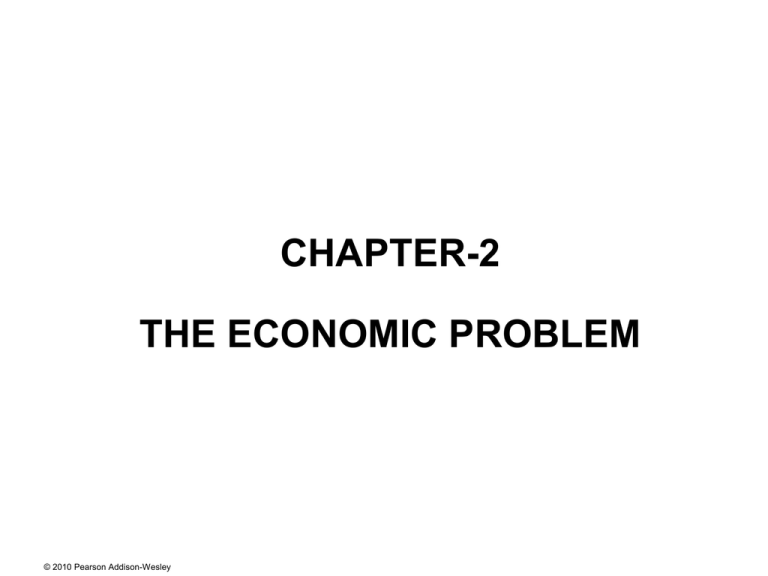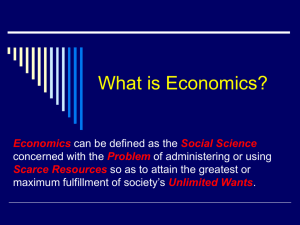
CHAPTER-2
THE ECONOMIC PROBLEM
© 2010 Pearson Addison-Wesley
Why does food cost much more today than it did a few
years ago?
We use an economic model—the production
possibilities frontier—to explain the economic problem.
(Scarcity-problem)
We also use this model to study how we can expand
our production possibilities; how we gain by trading with
others; and why the social institutions have evolved.
© 2010 Pearson Addison-Wesley
Production Possibilities and
Opportunity Cost
The production possibilities frontier (PPF) is the
boundary between those combinations of goods and
services that can be produced and those that cannot.
To illustrate the PPF, we focus on two goods at a time and
hold the quantities of all other goods and services
constant.
That is, we look at a model economy in which everything
remains the same (ceteris paribus) except the two goods
we’re considering.
© 2010 Pearson Addison-Wesley
Production Possibilities and
Opportunity Cost
Production Possibilities
Frontier
Figure 2.1 shows the PPF
for two goods: cola and
pizza.
Any point on the frontier
such as E and any point
inside the PPF such as Z
are attainable.
Points outside the PPF
are unattainable.
© 2010 Pearson Addison-Wesley
Production Possibilities and
Opportunity Cost
Production Efficiency
We achieve production
efficiency if we cannot
produce more of one good
without producing less of
some other good.
Points on the frontier are
efficient.
© 2010 Pearson Addison-Wesley
Production Possibilities and
Opportunity Cost
Any point inside the
frontier, such as Z, is
inefficient.
At such a point, it is
possible to produce more
of one good without
producing less of the
other good.
At Z, resources are either
unemployed or
misallocated.
© 2010 Pearson Addison-Wesley
Production Possibilities and
Opportunity Cost
Tradeoff Along the PPF
Every choice along the
PPF involves a tradeoff.
On this PPF, we must give
up some cola to get more
pizzas or give up some
pizzas to get more cola.
© 2010 Pearson Addison-Wesley
Production Possibilities and
Opportunity Cost
Opportunity Cost
As we move down along
the PPF, we produce
more pizzas, but the
quantity of cola we can
produce decreases.
The opportunity cost of a
pizza is the cola decline.
© 2010 Pearson Addison-Wesley
Production Possibilities and
Opportunity Cost
In moving from E to F,
the quantity of pizzas
increases by 1 million.
The quantity of cola
decreases by 5 million
cans.
The opportunity cost of
the pizzas is 5 million
cans of cola.
© 2010 Pearson Addison-Wesley
Production Possibilities and
Opportunity Cost
In moving from F to E, the
quantity of cola produced
increases by 5 million.
The quantity of pizzas
decreases by 1 million.
© 2010 Pearson Addison-Wesley
Production Possibilities and
Opportunity Cost
Because resources are
not equally productive in
all activities, the PPF
bows outward—is
concave.
The outward bow of the
PPF means that as the
quantity produced of each
good increases, so does
its opportunity cost.
© 2010 Pearson Addison-Wesley
Using Resources Efficiently
All the points along the PPF are efficient.
To determine which of the alternative efficient quantities
to produce, we compare costs and benefits.
The PPF and Marginal Cost
The PPF determines opportunity cost.
The marginal cost of a good or service is the opportunity
cost of producing one more unit of it.
© 2010 Pearson Addison-Wesley
Using Resources Efficiently
Figure 2.2 illustrates the
marginal cost of pizza.
As we move along the
PPF in part (a), the
opportunity cost of a
pizza increases.
The opportunity cost of
producing one more
pizza is the marginal
cost of a pizza.
© 2010 Pearson Addison-Wesley
Using Resources Efficiently
In part (b) of Fig. 2.2, the
bars illustrate the
increasing opportunity
cost of pizza.
The black dots and the
line MC show the
marginal cost of pizza.
The MC curve passes
through the center of each
bar.
© 2010 Pearson Addison-Wesley
Using Resources Efficiently
Preferences and Marginal Benefit
Preferences are a description of a person’s likes and
dislikes.
To describe preferences, economists use the concepts of
marginal benefit and the marginal benefit curve.
The marginal benefit of a good or service is the benefit
received from consuming one more unit of it.
We measure marginal benefit by the amount that a
person is willing to pay for an additional unit of a good or
service.
© 2010 Pearson Addison-Wesley
Using Resources Efficiently
It is a general principle that the more we have of any
good, the smaller is its marginal benefit and the less we
are willing to pay for an additional unit of it.
We call this general principle the principle of decreasing
marginal benefit.
The marginal benefit curve shows the relationship
between the marginal benefit of a good and the quantity
of that good consumed.
© 2010 Pearson Addison-Wesley
Using Resources Efficiently
Figure 2.3 shows a
marginal benefit curve.
The curve slopes
downward to reflect the
principle of decreasing
marginal benefit.
At point A, with pizza
production at 0.5 million,
people are willing to pay
5 cans of cola for a
pizza.
© 2010 Pearson Addison-Wesley
Using Resources Efficiently
At point B, with pizza
production at 1.5 million,
people are willing to pay
4 cans of cola for a
pizza.
At point E, with pizza
production at 4.5 million,
people are willing to pay
1 can of cola for a pizza.
© 2010 Pearson Addison-Wesley
Using Resources Efficiently
Allocative Efficiency
When we cannot produce more of any one good without
giving up some other good, we have achieved production
efficiency.
We are producing at a point on the PPF.
When we cannot produce more of any one good without
giving up some other good that we value more highly, we
have achieved allocative efficiency.
We are producing at the point on the PPF that we prefer
above all other points.
© 2010 Pearson Addison-Wesley
Using Resources Efficiently
Figure 2.4 illustrates
allocative efficiency.
The point of allocative
efficiency is the point on
the PPF at which marginal
benefit equals marginal
cost.
© 2010 Pearson Addison-Wesley
Using Resources Efficiently
If we produce less than
2.5 million pizzas, i.e. an
equilibrium, the marginal
benefit exceeds the
marginal cost.
© 2010 Pearson Addison-Wesley
Using Resources Efficiently
If we produce more than
2.5 million pizzas, i.e. the
equilibrium, the marginal
cost exceeds marginal
benefit.
© 2010 Pearson Addison-Wesley
Using Resources Efficiently
If we produce exactly
2.5 million pizzas, i.e. at
the equilibrium, the
marginal cost equals
marginal benefit.
© 2010 Pearson Addison-Wesley
Economic Growth
The expansion of production possibilities—and increase in
the standard of living—is called economic growth.
Two key factors influence economic growth:
Technological change
Capital accumulation
Technological change is the development of new goods
and of better ways of producing goods and services.
Capital accumulation is the growth of capital resources,
which includes human capital.
© 2010 Pearson Addison-Wesley
Economic Growth
The Cost of Economic Growth
To use resources in research and development and
to produce new capital, we must decrease our
production of consumption goods and services.
So economic growth is not free.
The opportunity cost of economic growth is less
current consumption.
© 2010 Pearson Addison-Wesley
Economic Growth
Figure 2.5 illustrates the
tradeoff we face.
We can produce pizzas or
pizza ovens along PPF0.
By using some resources
to produce pizza ovens
today, the PPF shifts
outward in the future.
© 2010 Pearson Addison-Wesley









